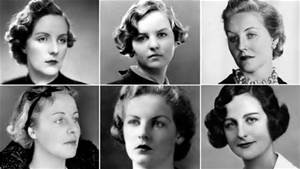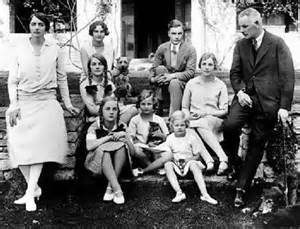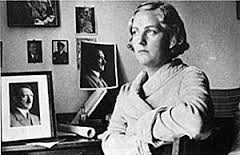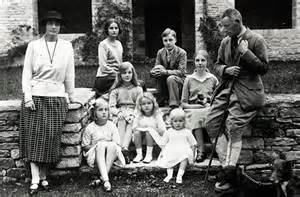Much Ado about the Mitfords
You could say they were kind of like the Kennedys and also the Kardashians—but that wouldn’t quite paint the picture. Not by a long shot.

For three years, a small group of playwrights worked with TimeLine Literary Manager Ben Thiem in a series of meetings, workshops and readings to develop a new play from start to finish. We asked each playwright in the 2013-2016 inaugural Playwrights Collective to talk a little bit about their play and their process, to be featured on Behind the ‘Line. Today we show you what inspired playwright Susan McLaughlin Karp‘s newest work.
They were the Mitford sisters and there were six of them: Nancy, Pam, Diana, Unity, Jessica, and Deborah. And near my desk there are more than 20 books about them, including family histories, group biographies, collections of their letters, lifestyle manuals, memoirs of their unique childhood, numerous novels (primarily by eldest sister Nancy), diaries, and individual biographies of all but one sister. There’s even a book (perfectly entitled The Other Mitford) about Pam, the quiet homebody who loved animals and making soup.
The question is, why? Why the fascination with the Mitfords?
The answer may be the list of people who were friends with one or more of them: Dora Carrington, Hitler, Maya Angelou, JFK, Evelyn Waugh, The Duke and Duchess of Windsor, Christopher Hitchens, Prince Aly Khan, and—of course—Churchill.

As young ladies they were outrageous, at least by the standards of post-Victorian England between the World Wars. At a time when women obeyed strict social rules and the dictates of their parents, the Mitfords pushed boundaries and followed their passions and convictions without apology or concern for popular opinion. Their behavior was, by turns, exciting, selfish, ignorant, brave and ugly. You could say they were kind of like the Kennedys and also the Kardashians—but that wouldn’t quite paint the picture. Not by a long shot.
Instead, the picture would look a little more like this:

If Alec Baldwin was a little more like Clark Griswold and Martha Stewart was a lot more like Annie Hall, they would get married and live on a beautiful Connecticut farm where they’d raise a large family of six girls and one boy. Though plagued with ever increasing financial difficulties due to Alec/Clark’s uncanny ability to always invest in the wrong thing, they would be saved by Martha/Annie’s frugality and a strangely lucrative knack for raising chickens and selling their eggs to a select group of fine restaurants—allowing them to get by.
Then, imagine if their daughters grew up to be celebrities, something along the lines of Gwyneth Paltrow, Angelina Jolie, Taylor Swift, Drew Barrymore, Scarlett Johansson, and Beyoncé if they were all from the same family, but only if Gwyneth could write like Nora Ephron and Drew was really into organic farming, while Beyoncé was busy managing the Winterthur Museum and blogging about it. That gives you some idea of what the Mitford girls were like during their heyday, until, of course, things got complicated: Angelina left Brad Pitt for Rand Paul; Taylor Swift moved to Russia and became a Vladimir Putin groupie; and Scarlett ran off with Russell Brand to fight ISIS in Syria.


The turning point was World War II. Diana, regarded as the most beautiful woman in England, had already left her husband, Brian Guinness (heir to the gigantic Guinness brewing fortune) for Oswald Mosley, the leader of Britain’s Fascist party. Unity, a would-be artist whose main subject was Hannibal the Great, became enthralled by Hitler. Unable to choose between England and her adopted Germany, Unity attempted suicide on the day England went to war with Germany. The bullet she used to shoot herself could not be removed from her brain, leaving it irreparably damaged. Their only brother died in the war, as did Jessica’s husband and Deborah’s brother-in-law and her best friend. Diana was labeled an enemy of England and wound up in prison.
When the war was over, their parents were estranged, while Jessica never forgave Diana for introducing Unity to Hitler. Deborah and Nancy never forgave Jessica for running away and becoming an American. Nancy couldn’t forgive Diana her great beauty. Diana bore no grudges but would never apologize for her politics. Deborah would prefer that politics were never discussed at all.

As Nancy would write in her novel, The Pursuit of Love:
“There they are, held like flies in the amber of that moment—click goes the camera and on goes life; the minutes, the days, the years, the decades, taking them further and further from that happiness and promise of youth, from the hopes Aunt Sadie must have had for them, and from the dreams they dreamed for themselves. I often think there is nothing quite so poignantly sad as (photographs of) old family groups.”
This post is third in a blog series reflecting on the work of the 2013-2016 Playwrights Collective. Read the other posts in the series:
- Literary Manager Ben Thiem on the challenges of writing history
- Playwright John Conroy on making sense of a very personal experience with crime
- Playwright Brett Neveu on the development of his play To Catch a Fish, now slated to premiere in our 2017-18 season
- Playwright Alice Austen on seeking further understanding Russia and the Russian mentality
- Playwright Frances Limoncelli on a story that encourages us to see the racism within us, not just outside of us
- Playwright Emily Dendinger on a magical woman who went after what she wanted, despite obstacles
